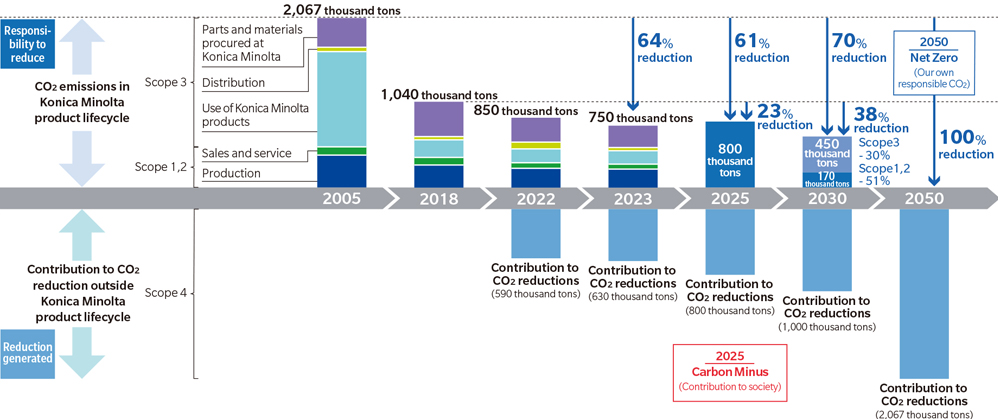Material Issue 4
Addressing Climate Change
Background
|
Social and Environmental Issue Outlook for 2030 Under the Paris Agreement, the entire world could transition to a low-carbon society at an accelerated and ambitious pace. However, there are concerns that the necessary changes will not happen fast enough, leading to harsh impacts from climate change. If and when a low-carbon society is achieved, the energy structure of entire industries will have changed significantly, including the widespread use of renewable energy and dramatic energy savings. Conversely, if dire climate change predictions materialize, rising sea levels will submerge coastlines and damage biodiversity. There will also likely be frequent severe weather events, such as typhoons and hurricanes, which could have a significant impact on both industries and people's lives. |
Climate-related Financial Information Disclosure(TCFD)
|
Opportunities for Konica Minolta to create value, and risks to be minimized |
|||
|
|
||
| Social/Environmental Impact | Major Stakeholders | |
|---|---|---|
| Positive |
|
|
| Negative |
|
|
Vision for 2030 and Medium-Term Plan
Reducing CO₂ emissions at Konica Minolta, while expanding CO₂ reductions among its customers and suppliers
For metrics/targets and results over the years, please refer to the "Addressing Climate Change" table in the Sustainability Goals and Results page's list of goals and results (PDF).
Konica Minolta's Approach
With the formulation of its Medium-Term Business Plan 2025, Konica Minolta has declared it will achieve Carbon Minus status by 2025, five years earlier than its previous target of 2030.
As its business shifts from products to services through DX, Konica Minolta will shift its Carbon Minus initiatives to activities that actively leverage DX. Konica Minolta will help transform the conventional business model of mass production and disposal by supporting clients with on-demand production, imaging IoT technologies, and other innovations, while helping to minimize energy use in the digital society.
Leveraging digital transformation (DX) technologies, Konica Minolta will pursue collaboration with even more corporate clients and business partners, taking on the challenge of promoting broad-scale environmental impact reduction. The company aims to achieve sustainable growth by dramatically expanding its contribution to the reduction of environmental impact while improving financial performance. This will be done by utilizing digital technology by promoting its Carbon Neutral Partner Activities that provide business partners with Konica Minolta environmental expertise, and by promoting the Environmental Digital Platform launched in June 2020.
Recently, as an "investment in technology for growth areas," the Company has been working on "bio-manufacturing," which is being researched worldwide as the next generation of manufacturing. Konica Minolta established the "Bio-Process Technology Collaboration Research Laboratory" in partnership with the National Institute of Advanced Industrial Science and Technology, aiming to achieve net zero using raw materials derived from non-fossil resources by leveraging sensing technology and AI.
*Carbon Minus: A state where the amount of CO2 reduction contributed outside the Company's defined scope of responsibility (Scope 1, 2, and 3) is greater than the CO2 emissions within that scope.

Businesses: Reducing Energy Usage and CO2 Emissions by Transforming Customer Processes
●Contributing to Resource Circulation and Climate Action through Sensing Technology
●Energy Conservation in MFPs and Digital Printers
●Reducing energy usage and CO2 emissions in customer business processes through on-demand printing and production
- Using Digital Technology to Reduce the Environmental Impact of Commercial Printing
- Energy Conservation and Greenhouse Gas Prevention with Products — UV Inkjet Digital Printing Machine That Helps
●Streamlining gas leak inspection work and compliance activities related to global warming prevention regulations
●Collaborating with customers globally through the Environmental Digital Platform, a DX-based ecosystem
●Achieving net zero through “bio-manufacturing” that supports the shift away from fossil resources
Internal Action: Energy Usage and CO2 Emissions Reduction Related to Konica Minolta Sites, Business Partners, Products and Services
●Reducing environmental impact and costs at Konica Minolta sites
●Reducing environmental impact and costs at business partners using DX
●Reducing the environmental impact of products

